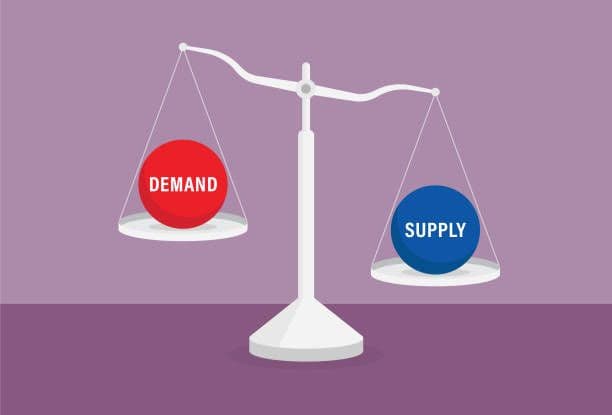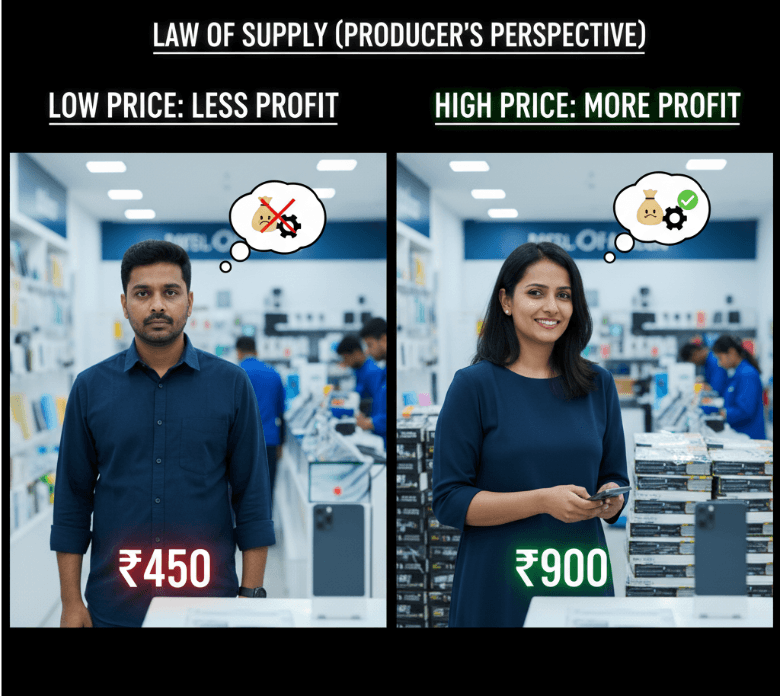Law of Demand and Supply: UPSC Explainer
8 min read
Nov 18, 2025

Relevance and Importance
- Prelims Reality: Only 2 questions in last 10 years
- Why Still Critical:
> Foundation for understanding inflation and monetary policy dynamics, rupee appreciation/depreciation and other concepts.
> Every economic news connects to these basics. Petrol price hike? (Supply-demand). Onion crisis? (Supply shock).Global crude oil price shocks. EMI boom? (Credit affecting demand). Once you grasp this foundation, economics becomes predictable!
Law of Demand: The Consumer's Perspective

What Does Demand Mean?
Demand isn't just "wanting" something. It's the quantity of goods consumers are willing AND able to purchase at different price levels during a specific period.
Example: 1000 people want an iPhone at ₹1 lakh with only 100 having ability to pay ,so demand is created by 100 people only.
What is the Law of Demand?
Core Rule: When price goes up, people buy less. When price goes down, people buy more.
- Price ↑ → Quantity Demanded ↓
- Price ↓ → Quantity Demanded ↑
Example:
Reasons Behind Law of Demand
- Income Effect: Higher prices reduce your real purchasing power. You can buy less with the income you have. Remember when we feel poorer → we buy less.
- Substitution Effect: You substitute expensive item with cheaper one. Expensive coffee then you switch to alternative tea
- Law of Diminishing Marginal Utility: satisfaction from one additional unit gives less happiness. One is not willing to pay more(price increase) for more (demand increase) as satisfaction decreases with increasing consumption.
Example: First samosa = heaven, fifth samosa = meh
- 1st samosa when hungry = 10/10 satisfaction
- 5th samosa when full = 2/10 satisfaction
- So you'll only buy 5th samosa if price is very low
Exceptions to Law of Demand (Do not follow the Law)
- Giffen Goods: There are basic necessities for very poor and inferior goods where demand rises with price (classic example: staple food during famine).
> This is because they're so inferior that the income effect dominates - when price rises, you're poorer, so you buy MORE of the cheap staple and less of everything else.
> Why this happens:
1. Poor family spends ₹100: ₹80 on rice, ₹20 on dal
2. Rice price doubles → Can't afford dal anymore
3. Forced to spend entire ₹100 on rice to survive
4. Buying MORE rice despite the highe price!
- Veblen Goods: Status symbols like luxury cars – higher price = more prestige = more demand. Conspicuous consumption - buying to signal wealth/status.
1. So drop in prices reduces their demand rather than increasing it as in case of law of demand.Example - Iphones after one year when the latest new model releases.
- Necessities: Life-saving medicines – you'll buy regardless of price
- Speculation: Buying because you expect prices to rise more. Share market behavior during bull runs -Shares at ₹1000 → People think it'll reach ₹2000 → Buy more despite high price
Other Factors Influencing Demand (Beyond Price)
Price of Related Goods
Substitute Goods (Either-Or Products)
- Relationship: If X price ↑ → Y demand ↑
- Why: People switch to alternatives
- Examples with numbers:
> Coffee ₹100 → ₹150: Tea demand increases 30%
> Petrol ₹100 → ₹120: CNG car sales jump
> Butter expensive: Margarine sales rise
Complementary Goods (Used Together)
- Relationship: If X price ↑ → Y demand ↓
- Why: Both needed together, one becoming costly reduces combined use
- Examples with numbers:
>Petrol ₹100 → ₹150: Car demand drops 20%
>Printer cheap but ink expensive: Printer demand falls
>Movie ticket ₹500: Popcorn sales decrease
Consumer's Income Changes
- Normal Goods (Most everyday products)
>Pattern: Income ↑ → Demand ↑
>Why: More money = ability to buy more/better things
>Example: Salary doubles → Buy car instead of bike
- Inferior Goods (Poor substitutes)
>Pattern: Income ↑ → Demand ↓
>Why: People upgrade to better alternatives
>Example:
1. Poor student: Eats ₹10 Maggi daily
2. Gets job: Shifts to ₹50 proper meals
3. Maggi demand decreases despite having more money!
Non-Quantifiable Factors
- Taste and Preference: Yoga mats post-COVID, organic food trend
- Future Price Expectations: GST announcement? People rush to buy before implementation
- Demographics: Aging Japan = healthcare demand; Young India = education demand
- Government Policies: Subsidies boost demand; taxes reduce it
- Credit Availability: Easy EMIs = more iPhone purchases
Elasticity of Demand: The Responsiveness Meter
Price Elasticity
How sensitive is demand to price changes? Does demand change significantly with small price changes or does it not change?
PED = (% Change in Quantity) ÷ (% Change in Price)
Types of Elasticity:
- Elastic Demand (PED > 1)
>Meaning: Small price change → Large quantity change
>Example: Movie tickets ₹200 → ₹250 (25% rise) → Viewers drop from 100 → 60 (40% fall)
>PED = 40% ÷ 25% = 1.6
>Products: Luxuries, entertainment, items with many substitutes
- Inelastic Demand (PED < 1)
>Meaning: Large price change → Small quantity change
>Example: Salt ₹20 → ₹30 (50% rise) → Consumption 1kg → 0.95kg (5% fall)
>PED = 5% ÷ 50% = 0.1
>Products: Necessities, addictive products, no substitutes
Unitary Elastic (PED = 1)
Meaning: Price and quantity change proportionally
Revenue remains constant
Cross Price Elasticity
Measures how one product's price affects another's demand.
For Substitutes: Positive value
- Coffee price ↑10% → Tea demand ↑5% → Cross elasticity = +0.5
For Complements: Negative value
- Petrol price ↑10% → Car demand ↓3% → Cross elasticity = -0.3
Income Elasticity
Tracks demand changes with income fluctuations. Helps identify luxury vs necessity goods.
Luxury goods (>1): Income ↑10% → AC demand ↑20%
Necessities (0 to 1): Income ↑10% → Food demand ↑3%
Inferior goods (<0): Income ↑10% → Bus travel ↓5%
Law of Supply: The Producer's Perspective

Core Rule: Higher prices motivate more production
- Price ↑ → Quantity Supplied ↑
- Price ↓ → Quantity Supplied ↓
Why This Happens:
- Profit motive: Higher price = Higher profit margin
- Cost coverage: Higher prices cover increasing production costs
Example:
- Onions at ₹20/kg → Farmers plant normal amount
- Onions at ₹80/kg → Every farmer rushes to plant onions
- Next season → Oversupply → Price crash
Market Equilibrium: Where Magic Happens
What?
The sweet spot where demand equals supply. No shortage, no surplus – just right. Market-determined price where both buyers and sellers are satisfied.
Characteristics:
- No leftover stock (surplus)
- No queues/shortage
- No pressure to change price
- Example: If 1000 people want phones at ₹50,000 and companies want to sell exactly 1000 phones at ₹50,000
How Markets Self-Correct - The Invisible Hand (Price Mechanism)

Excess Demand Correction: Shortage → Consumers compete → Prices rise → Demand falls(Law of Demand) + Supply rises(Law of Supply) → Equilibrium restored
Example: Oxygen cylinders during COVID second wave – initial shortage led to price spikes, attracting more suppliers while reducing panic buying.
Excess Supply Correction: Surplus → Sellers compete → Prices fall → Demand rises (Law of Demand) + Supply falls (Law of Supply) → Equilibrium restored
Example: Bumper tomato crop → Prices crash → Farmers reduce cultivation + Consumers buy more → Balance returns
Limitations of Market Mechanism
Market Mechanism Failures: When Invisible Hand Doesn't Work
- Public Goods Problem
>Non-excludable: Can't stop non-payers from using
Street light benefits all, whether they paid tax or not
>Non-rivalrous: One person's use doesn't reduce availability
You enjoying streetlight doesn't dim it for others
Result: No private company will provide → Government must step in
- Monopoly Power
Problem: Single seller controls price
Example: Only one company selling life-saving drug
Result: Charges ₹10,000 for ₹100 cost medicine
Solution: Government price controls/regulations
- Externalities (Hidden Costs/Benefits)
Negative externality: Factory's private cost ₹100, but pollution damage ₹50
>Market price doesn't include pollution cost
>Society bears extra ₹50
Positive externality: Education benefits individual AND society
>Market undervalues total benefit
>Government subsidizes to increase consumption
- Information Asymmetry
>Used car market ("Lemons problem"):
Seller knows car condition, buyer doesn't
Buyers assume all cars are bad → Offer low price
Good car owners exit market → Only bad cars remain
Insurance: Sick people more likely to buy → Premiums rise → Healthy exit
- Merit Goods
Problem: People undervalue long-term benefits
Examples:
Education: Immediate cost visible, future benefit ignored
Preventive healthcare: Vaccination skipped, later disease costly
Solution: Government makes it free/compulsory
- Income Inequality
Problem: Market allocates to those who can pay, not who need most
Example: Rich buy 3rd car while poor can't afford bicycle
Solution: Progressive taxation + welfare schemes
Mixed Economy Solution:
- Definition: Combination of market forces (for most goods) + government intervention (for market failures)
- India's approach: Markets handle phones, clothes, food + Government provides defense, subsidizes education, regulates monopolies
Remember: Demand-Supply isn't just theory – it's the lens through which you'll decode economic current affairs, understand RBI decisions, and analyze government policies. Master this foundation now, and watch economics questions become predictable!
UPSC PYQ (2021)
Q1. Consider the following statements:
Other things remaining unchanged, market demand for a good might increase if
price of its substitute increases
price of its complement increases
the good is an inferior good and income of the consumers increases
its price falls
Which of the above statements are correct?
(a) 1 and 4 only (b) 2, 3 and 4 (c) 1, 3 and 4 (d) 1, 2 and 3
The correct answer is (a) 1 and 4 only.
Explanation
Why Statements 1 and 4 are Correct
1. Price of its substitute increases: If a substitute good becomes more expensive, consumers will switch to the cheaper alternative, thus increasing the demand for the good in question.
4. Its price falls: A decrease in a good's own price leads to an increase in the quantity demanded, as per the law of demand.
Why Statements 2 and 3 are Incorrect
2. Price of its complement increases: If a complementary good (one used together with the original) becomes more expensive, demand for the original good will decrease.
3. The good is an inferior good and income of the consumers increases: The demand for an inferior good decreases when consumer income rises, as consumers switch to more desirable alternatives.
Frequently Asked Questions (FAQs)
Is demand just "wanting" something?
A: No! Demand = Desire + Purchasing Power + Specific Time Period. A homeless person may desire a car but has no effective demand without money.
Why does Law of Demand fail sometimes?
A: Four main exceptions:
- Giffen goods (ultra-poor's staples)
- Veblen goods (status symbols)
- Life necessities (medicines)
- Speculation bubbles (crypto, stocks)
How many questions come from the topic of Law of Demand and Supply?
A: Direct questions: 2 in 10 years. But it's foundational for understanding:
- Inflation questions
- Current affairs on commodity prices
- Budget implications
Do I need to memorize elasticity formulas for UPSC?
A: No complex calculations needed. Just understand:
- Concept (responsive vs unresponsive)
- Examples (luxury vs necessity)
- Policy implications (tax on inelastic goods)
How is this linked to current affairs?
A: Everything! Examples:
- Crude oil prices → Petrol rates → Inflation
- Ukraine war → Wheat supply → Food prices
- RBI rate changes → Credit demand → Economic growth
Why doesn't the government always let markets self-correct?
A: Due to Market failures following things are not provided adequately for by market :
- Essential goods (can't let poor starve during shortage)
- Time lag (correction takes time, people suffer meanwhile)
- Monopolies (no competition to correct)
- Public goods (no profit incentive)
Therefore the government has to intervene in markets to provide the above goods.
Are luxury goods always elastic?
A: Generally yes, but ultra-luxury can be inelastic (super-rich don't care about price). It's about the consumer segment.
If price rises reduce demand, why do shares/gold prices keep rising?
A: Speculation exception! People buy expecting further rise. Also, these are assets (store value), not consumption goods.